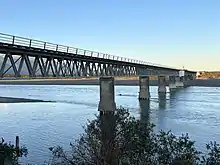| Haast River | |
|---|---|
 Haast River near Roaring Billy Falls | |
| Location | |
| Country | New Zealand |
| Physical characteristics | |
| Source | |
| • location | Southern Alps / Kā Tiritiri o te Moana |
| Mouth | |
• location | Tasman Sea |
| Length | 100 km (62 mi) |
The Haast River / Awarua is a river on the West Coast of the South Island of New Zealand. The Māori name for the river is Awarua. It drains the western watershed of the Haast Pass. The Haast River is 100 kilometres (62 mi) in length, and enters the Tasman Sea near Haast township. The river's main tributary is the Landsborough River.
Toponomy
Julius von Haast named the river after himself, "directed, so he said, by his Provincial Superintendent".[1] Von Haast explored a route from Otago to the West Coast that was long known to Māori; his four companions were William Young (a surveyor), Charles Håring (a retired sailor), William Francis Warner (later the proprietor of Warner's Hotel), and Robert Langley Holmes (later the Canterbury provincial meteorologist). They set out on 22 January 1863 and stood in the surf on 20 February.[2]
Geography

The river is set within the Te Wahipounamu World Heritage Site. The majority of the surrounding land is publicly owned and administered by the Department of Conservation. The grassy flats on the lower reaches are grazed by cattle owned by the local farmers. Tourism operators offer jetboat tours on the river.
State Highway 6 follows virtually the complete length of the river. From near Haast Pass, the state highway is located on the river's true left. It switches to the true right at the Gates of Haast Bridge. At Pleasant Flat, where the valley widens out, the state highway crosses back to the true left.[3] The final bridge is near the coast, just after the turnoff to the Haast township. At 737 metres (2,418 ft) it is the longest one-lane road bridge in New Zealand, and the 7th longest New Zealand bridge overall.[4]
The Haast plain
.jpg.webp)
The Haast plain extends 50 km (31 mi) from Ship Creek to Jackson Bay / Okahu. The plain has an unusual landform, with long parallel lines of low hills with narrow swales in between. In some places, the plain is 10 km (6.2 mi) wide, with six rows of dunes and swales. The landform results from the combined effects of sediment carried to the coast by six large rivers, longshore drift and periodic seismic uplifts. The rivers discharging into the Tasman sea in this region of coastline drain from large catchment areas in the Southern Alps, where there is high rainfall and the mountains have high rates of erosion.[5] The suspended sediment yield of the Arawhata River has been reported as 7.18 Mt/yr, and the Haast River as 5.93 Mt/yr. The total estimated suspended sediment yield from rivers in South Westland is over 50 Mt/yr.[6] Longshore drift leads to much of this sediment being deposited along the Haast coastline, forming dunes. The Alpine Fault runs along the inland edge of the plain, and the entire area is subject to tectonic uplift during major seismic events. Following a major uplift, existing dunes are no longer exposed to the action of the sea, and new dunes begin to form. This creates a longitudinal pattern of dunes with low-lying wetlands in between. The coastal plain is approximately 6,000 years old. The dunes close to the current shoreline have little vegetation, but the older dunes further inland are forested with tall podocarps. The swales contain wetland lakes, pakihi and kahikitea swamp forests.[5]
See also
References
- ↑ Pascoe, John Dobree (1966). The Haast is in South Westland (1 ed.). Wellington: AH & AW Reed.
- ↑ Holm, Janet (2005). Caught mapping: the life and times of New Zealand's early surveyors. Christchurch: Hazard Press. pp. 165–169. OCLC 636380050.
- ↑ "NZ Topo Map". topomap.co.nz. Retrieved 5 January 2020.
- ↑ "Transit New Zealand Frequently Asked Questions". Archived from the original on 19 June 2008. Retrieved 23 September 2008.
- 1 2 Kerry-Jayne Wilson (2017). West Coast Walking: A naturalist's guide (2nd ed.). Christchurch: Canterbury University Press. ISBN 978-1-927145-42-5. OL 29806566M. Wikidata Q98762244.
- ↑ D. Murray Hicks; Ude Shankar; Alistair I. McKerchar; Les Basher; Murray Jessen; Ian Lynn; Mike Page (2011). "Suspended sediment yields from New Zealand rivers" (PDF). Journal of Hydrology (New Zealand). 50 (1): 81–142. ISSN 0022-1708. Wikidata Q113624133.
External links
 Media related to Haast River at Wikimedia Commons
Media related to Haast River at Wikimedia Commons